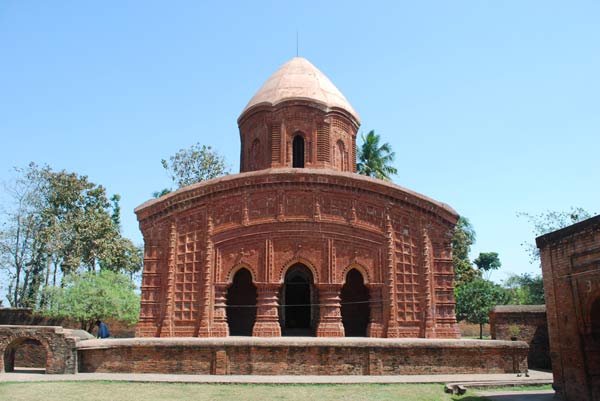Next weekend you can be at ... Guptipara
If you want to spend the next weekend exploring the home of Bengal’s first community Durga puja, the place where Bengali sweets graduated from makha sandesh (sandesh mixture) to gupo sandesh (a variety of sandesh pieces), and the birth place of legendary folk singer Bhola Moira amid terracotta temples, then Guptipara would be an ideal destination.

Located 75 km from Howrah on the Bandel-Katwa railway line, Guptipara can be reached in less than two hours by train.
Once you’re there, head straight for the temple complex, housing four Vaishnava temples — Chaitanya, Brindabanchandra, Ramchandra and Krishnachandra — which offer an interesting mix of Bengal’s temple architecture.
The temples were constructed in different periods. The Chaitanya temple, built by Bishwar Roy in the mid-sixteenth century, is the oldest. The temple consists of two thatched hut-shaped structures. The structure was adorned with some of Bengal’s earliest terracotta carvings, but they didn’t survive the march of time.
The 60-feet high Brindabanchandra temple, built in 1810, dominates the temple complex. The aatchala temple doesn’t have terracotta work but that is compensated by the colourful paintings on both the outer and inner walls. The Brindabanchandra temple is flanked on the left by the Ramchandra temple and on the left by the Krishnachandra temple.

The ekratna (single pinnacled) Ramchandra Temple was constructed in late 18th century by Harishchandra Roy, the king of Seoraphuli. It may be called the most elegant temple in the complex. The single-storey temple with an octagonal turret contains rich terracotta work on the walls and the turret. The carvings depict war scenes from the Ramayana, royal processions, voyages and glimpses of everyday life.
The Krishnachandra temple was constructed in 1745 during the rule of Nawab Ali Vardi Khan and is also in the aatchala form. All the temples stand on elevated platforms and are interconnected by narrow, arched passageways.
The heritage of Guptipara is not restricted to its temples alone. The place was a stronghold of Vaishnava culture. Even today, residents observe Ras, Dol and Rath festivals with great enthusiasm.
Rath Yatra is Guptipara’s biggest festival. The Guptipara rath, one of the tallest in Bengal, covers the longest distance after the Puri rath. A day before Ultarath, a festival called Bhandarloot is held here.
Bengal’s first community Durga puja was organised in Guptipara when some men were stopped from taking part in a household Durga puja. Twelve of them formed a committee and organised a barowari (baro means 12) puja. There is, however, some debate about the year the puja was started.
Guptipara is also the birthplace of kabiyal (folk singer) Bholanath Nayak, popularly known as Bhola Moira, who was defeated by the legendary Antony Firingi in a musical duel.
Guptipara is a great place for those with a sweet tooth. The place is famous for gupo sandesh, considered by many as Bangal’s first branded sweetmeat.
The Durga temple where the first community puja was held can still be seen but hardly any trace remains of Bhola Moira’s birthplace.
Going
The Howrah-Katwa local takes about 1 hour 45 minutes to reach Guptipara. Take a rickshaw from the station. Charges are around Rs 75 per rickshaw.
Staying
The place can be visited on a day trip. There are several places to eat.
(METRO ON SUNDAY THANKS READER RANGAN DATTA FOR THIS CONTRIBUTION. PICTURES BY AUTHOR)
|

